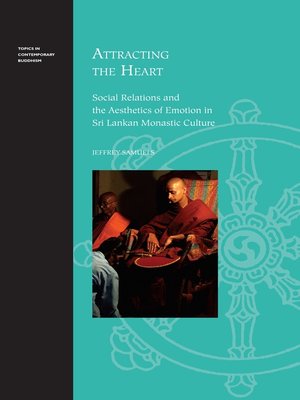Attracting the Heart
ebook ∣ Social Relations and the Aesthetics of Emotion in Sri Lankan Monastic Culture · Topics in Contemporary Buddhism
By Jeffrey Samuels

Sign up to save your library
With an OverDrive account, you can save your favorite libraries for at-a-glance information about availability. Find out more about OverDrive accounts.
Find this title in Libby, the library reading app by OverDrive.



Search for a digital library with this title
Title found at these libraries:
| Loading... |
An idealized view of the lifestyle of a Buddhist monk might be described according to the doctrinal demand for emotional detachment and, ultimately, the cessation of all desire. Yet monks are also enjoined to practice compassion, a powerful emotion and equally lofty ideal, and live with every other human feeling—love, hate, jealousy, ambition—while relating to other monks and the lay community. In this important ethnography of Buddhism in Sri Lanka, Jeffrey Samuels takes an unprecedented look at how emotion determines and influences the commitments that laypeople and monastics make to each other and to the Buddhist religion in general. By focusing on "multimoment" histories, Samuels highlights specific junctures in which ideas about recruitment, vocation, patronage, and institution-building are dynamically negotiated and refined. Positing a nexus between aesthetics and affect, he illustrates not only how aesthetic responses trigger certain emotions, but also how personal and shared emotions, at the local level, shape notions of beauty.
Samuels uses the voices of informants to reveal the delicately negotiated character of lay-monastic relations and temple management. In the fields of religion and Buddhist studies there has been a growing recognition of the need to examine affective dimensions of religion. His work breaks new ground in that it answers questions about Buddhist emotions and the constitutive roles they play in social life and religious practice through a close, poignant look at small-scale temple and social networks. Throughout, Samuels makes the case for the need to account for emotions in making intelligible the behavior of religious participants and practitioners.
Drawing on a decade of fieldwork that includes numerous interviews as well as an examination of written and visual sources, Attracting the Heart conveys the manner in which Buddhists describe their own histories, experiences, and encounters as they relate to the formation and continuation of Buddhist monastic culture in contemporary Sri Lanka. The book will be of interest to scholars and students of religion, Buddhist studies, anthropology, and South and Southeast Asian studies.






